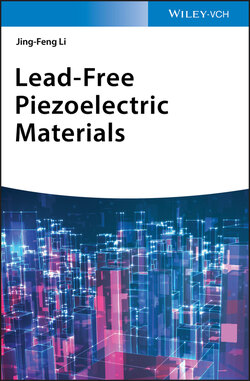Читать книгу Lead-Free Piezoelectric Materials - Jing-Feng Li - Страница 24
2 High‐Performance Lead‐Free Piezoelectrics 2.1 Introduction
ОглавлениеPiezoelectric materials are used in a large variety of applications including actuators, sensors, electromechanical motors, and sonar systems. In the future, the applications will be extended to energy harvesting systems for distributed low‐power systems. The global market for piezoelectric devices is estimated to be valued at US$ 25.1 billion in 2019 and projected to expand at a compounded annual growth rate of 6.2% through the next five years [1]. One of the most widely used piezoelectric ceramic materials is the solid solution of lead zirconate (PbZrO3) and lead titanate (PbTiO3), commonly known as PZT, with general formula PbZr1−xTixO3 [2]. As mentioned in Chapter 1, although BaTiO3 was discovered before lead zirconate titanate (PZT), the latter soon dominated the market for piezoelectric applications because of its comprehensively excellent piezoelectric properties and high Curie temperature as well as the flexibility for compositional modification to adjust to specific applications.
The outstanding properties of PZT originate from the nature of end‐number compounds and the phase structure evolution in their solid solutions. Both PbZrO3 and PbTiO3 have perovskite structure with Pb ions at the same A‐site. PbZrO3 is antiferroelectric, but PbTiO3 is ferroelectric [3]. Solid solutions are formed between them in a full range, but there exists a steep boundary where a transition occurs between the rhombohedral Zr‐rich phase and the tetragonal Ti‐rich phase, as shown in Figure 2.1. It should be noted that the tetragonal PbTiO3 has a high transition temperature to cubic phase, which endow high Curie temperature to PZT. The phase boundary separating two phases in a solid solution system is called morphotropic phase boundary (MPB), where piezoelectric coefficients, dielectric constant, and electromechanical coupling factor are greatly enhanced [4]. The “phase boundary” is also considered as a composition where the two phases are believed to coexist, which renders the materials more responsive to extra stimuli. It should be noticed that the MPB is nearly temperature independent, which is why the properties of PZT ceramics have excellent temperature stability. More in‐depth studies had been conducted regarding the nature of the MPB using advanced structural characterization techniques, leading to several modified versions of the PZT phase diagram. One representative work suggested that the MPB is a narrow region where monoclinic phases exist in between the tetragonal and rhombohedral phases [5, 6]. It seems that the hierarchical structures ubiquitously present in ferroelectric materials makes the phase diagram studies more complicated than non‐ferroelectric materials [7]. Nevertheless, a similar concept of MPB is useful and highly desirable for the development of lead‐free piezoelectric materials.
Figure 2.1 Phase diagram of the PbZrO3–PbTiO3 system. Note that there are revised phase diagrams showing an area instead of a line in the middle composition.
In addition to the existence of MPB, the properties of PZT ceramics can be adjusted relatively easily by chemical doping or substitution, which made PZT like “all‐around player” to meet a wide range of applications. In fact, piezoelectric ceramic devices can be classified as actuators, sensors, and transducers, which have specific property requirements. For example, “hard” PZT ceramics for high‐frequency transducers actuators need high mechanical quality factor (Qm), but sensors usually use “soft” PZT with enhanced d33. All kinds of PZT ceramics are commercially available. However, the large amount of lead contained in PZT materials has drawn much attention during the past decade, due to the environmental concern as well as governmental regulations against hazardous substances. In 2006, the European Union has already adopted the well‐known directives: Waste Electrical and Electronic Equipment (WEEE) and Restriction of the use of certain Hazardous Substances (RoHS) in electrical and electronic equipment, with the purpose of protecting human health as well as environment by exclusion or substitution of hazardous substances used in electrical and electronic devices [8]. Similar regulations have also been planned or established in North America, Japan, Korea, and China. Lead ranks foremost among the hazardous substances list due to its notoriety, with maximum allowed concentration of merely 0.1 wt%. Bearing the goal to reduce the production and waste disposal of toxic lead, the research on lead‐free piezoceramics strives to make PZT and similar perovskite materials redundant. Substantial effort has been devoted to the development of high‐performance lead‐free piezoelectric ceramics based on the several perovskite compounds [9], including BaTiO3, (K,Na)NbO3, (Bi0.5Na0.5)TiO3, and BiFeO3. In particular, great progress has been made since 2004 when Saito et al. reported (K,Na)NbO3 based lead‐free piezoelectrics with properties comparable with those found in PZT [10].
This chapter is set up to enable the readers quickly learn about the lead‐free piezoelectrics by introducing their brief history, crystal structure, and physical natures for BaTiO3, (K,Na)NbO3, (Bi0.5Na0.5)TiO3, and BiFeO3 systems. We first introduce BaTiO3 not only because it is the first lead‐free ferroelectric compound, but also for the purpose to show the intrinsic role of Pb by comparing BaTiO3 with PbTiO3, which is a representative lead‐containing ferroelectric. The detailed research progress about each system will be given in Chapters3–7.
